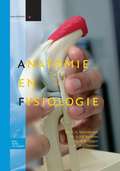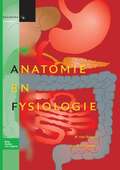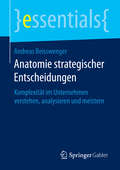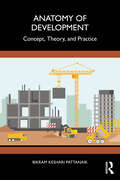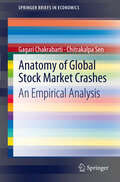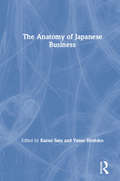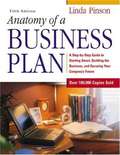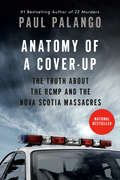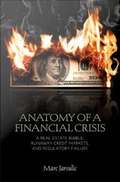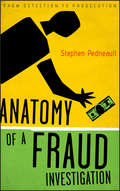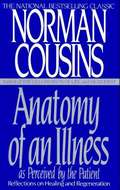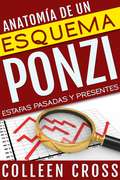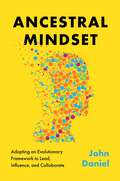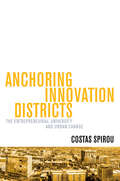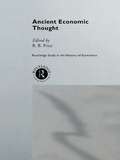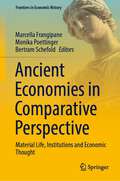- Table View
- List View
Anatomie en fysiologie: Basiswerk V&V, niveau 4 (Basiswerken Verpleging en Verzorging)
by Ij. D. Jüngen M. J. Tervoort C. A. Bastiaanssen A.A.F. JochemsVerpleegkundigen baseren hun handelen grotendeels op geneeskundige gegevens. Om deze gegevens juist te kunnen interpreteren, is een goede theoretische en praktische kennis van de anatomie en fysiologie nodig. Het basiswerk Anatomie en fysiologie geeft inzicht in de anatomie en in fysiologische processen, en is een uitstekende basis om pathologische verschijnselen bij de patiënt te leren herkennen, interpreteren en hier adequaat op te reageren.De anatomie houdt zich bezig met het bestuderen van de bouw van het menselijk lichaam. Onder fysiologie verstaan we de wetenschap van de verrichtingen van het menselijk lichaam en de functies van de verschillende onderdelen. In dertien hoofdstukken komen de verschillende onderdelen van anatomie en fysiologie aan de orde. Van circulatie tot zenuwstelsel, van zintuigen tot voortplanting: Anatomie en fysiologie geeft een compleet overzicht. De stof is logisch ingedeeld en sluit uitstekend aan bij het handelen in de praktijk. Het boek is bovendien rijk geïllustreerd.
Anatomie en fysiologie: Niveau 3 (Basiswerken Verpleging en Verzorging)
by N. HalemDit boek bevat alle basiskennis van anatomie en fysiologie die verzorgenden nodig hebben om hun beroep goed uit te kunnen oefenen. Kennis over het menselijk lichaam en inzicht in het functioneren ervan zijn belangrijke voorwaarden om op een veilige manier zorg te kunnen verlenen.Met Anatomie en fysiologie hebben verzorgenden een prettig leesbaar en logisch geordend boek in handen. De afbeeldingen en duidelijke tekst zorgen er voor dat leerlingen de theorie makkelijk eigen kunnen maken en verbanden leren begrijpen.In dit boek worden de verschillende orgaansystemen behandeld. Omdat de bouw - en functie van het lichaam sterk met elkaar samenhangen, komen beide steeds in elk hoofdstuk aan bod. Ook wordt er een duidelijke relatie gelegd tussen de fysiologie en ziekteverschijnselen. Hoe kunnen verzorgenden ziekteverschijnselen die zij zien, verklaren vanuit de anatomie en fysiologie? In elk hoofdstuk wordt in aparte kaders (in de rubriek In de praktijk) een aantal verschijnselen vanuit de fysiologie verklaard, bijvoorbeeld bij het hoofdstuk Spijsvertering: braken, geelzucht, obstipatie en diarree. Bij het hoofdstuk Huid: jeuk en bij hoofdstuk Zenuwstelsel wordt een verband gelegd tussen de anatomie en uitvalsverschijnselen.Zoveel mogelijk Nederlandse termen worden gebruikt, soms aangevuld met de meest voorkomende Latijnse namen. Achter in het basiswerk is een verklarende woordenlijst latijn-nederlands opgenomen, zodat leerlingen het altijd kunnen opzoeken.
Anatomie strategischer Entscheidungen: Komplexität im Unternehmen verstehen, analysieren und meistern (essentials)
by Andreas BeisswengerAndreas Beisswenger entwickelt aus der Analogie zwischen der Anatomie des Menschen und dem Aufbau von Entscheidungssituationen, die sich beide durch äußerste Komplexität auszeichnen, eine neue Sichtweise auf strategische Entscheidungen. Damit wird ein besseres Verständnis für diese geschaffen. Das essential analysiert den grundlegenden Aufbau hochkomplexer Entscheidungssituationen. Dies ist eine unabdingbare Voraussetzung für erfolgreiche strategische Maßnahmen. Der Autor stellt eine Entscheidungshilfe vor, welche eine reduktionistische Betrachtungsweise vermeidet, die oftmals Ursache für unzulängliche strategische Entscheidungen ist. Konkrete Hinweise zur Planung und Umsetzung eines strategischen Entscheidungsprozesses in der Praxis runden das essential ab.
Anatomy of Development: Concept, Theory, and Practice
by Bikram PattanaikThis book details the fundamentals of development studies by adopting a multi-disciplinary approach. It presents a balanced mix of economic, social, political, cultural and administrative premises of development and analyzes its theoretical and practical dimensions. It also provides insight into the role of the stakeholders of development in different sectors.The volume provides a holistic understanding of development, effectively demonstrating how it differs from economic growth. Beginning with development theories, paradigms and actors involved in the development process, this book goes on to explain the concepts of development administration, development governance, development planning, development management and development communication. One of the fundamental components of the book is the elucidation of Development Theories – classical, neoclassical, developmental and heterodox theories essential to the discipline of “development”.This book will be useful to undergraduate and postgraduate students, researchers, teachers of development studies, economics, sociology, political science, and public administration. It will also be useful to administrators and development administration officials of state and central governments, planners, policymakers and people working in NGOs, in addition to corporate sector functionaries dealing with corporate social responsibilities and those handling developmental issues and challenges.
Anatomy of Global Stock Market Crashes: An Empirical Analysis (SpringerBriefs in Economics)
by Chitrakalpa Sen Gagari ChakrabartiThis work is an exploration of the global market dynamics, their intrinsic natures, common trends and dynamic interlinkages during the stock market crises over the last twelve years. The study isolates different phases of crisis and differentiates between any crisis that remains confined to the region and those that take up a global dimension. The latent structure of the global stock market, the inter-regional and intra-regional stock market dynamics around the crises are analyzed to get a complete picture of the structure of the global stock market. The study further probing into the inherent nature of the global stock market in generating crisis finds the global market to be chaotic thus making the system intrinsically unstable or at best to follow knife-edge stability. The findings have significant bearing at theoretical level and on policy decisions.
Anatomy of Hard Talks: What Makes a Conversation Fail
by Holly WeeksEvery difficult conversation is unique, but what separates hard talks from normal conversations is not as individual as we might think. Across the board, there are three traits - with real costs - that make difficult conversations categorically different: combat mentality, emotional loads, and being hard to read. In addition, our simple and familiar ideas about how to handle tough conversations don't help us. We can't get through these conversations if we don't look more closely at what we actually do that makes them go bad.
Anatomy of Japanese Business
by Kasuo SatoThis volume collects eleven essays written by Japanese experts on various aspects of Japanese business management and is a sequel to the volume Industry and Business in Japan. It examines the mechanisms for Japan 's phenomenal economic growth since the Second World War by analyzing Japanese management, business groups, production systems and business strategy.
Anatomy of Regional Disparities in the Slovak Republic
by Mariusz Jarmuzek Biswajit BanerjeeA report from the International Monetary Fund.
Anatomy of Success: The Science of Inheriting Your Brain's Wealth & Power While You're Still Alive!
by Saleem BidaouiSome people are truly committed to do whatever it takes to change the status quo. They read all they can, attend seminars, and listen to CDs every day, but to no avail. Anatomy Of Success addresses this issue and provides insights on why some of us fail and what they should do to achieve what they want…on a permanent basis. The book has two parts. Part One is about understanding the mechanics of our brain and why we may, or may not, achieve what we want in life. Further, it’s about tapping into our true potential, and why & how every normal human being is fully equipped to reach any summit of success they may desire. Part Two, however, is about the tools, and the process, needed to complete the journey, naturally and effortlessly. Most of us use computer programs at minimum capacity simply because that’s all we know. Most of us use our brains in the same way. The goal of this book is to illustrate the real capacity and potency of our brains, then provide the essential tools, and the means, to achieve our dreams. Anatomy Of Success is unique in a sense that it not only has a wealth of scientific evidence about how the brain achieves success, but also provides a simple and easy process to clean up our bio-hard-drive, tune it up, then reprogram it for optimal success. The book appeals to those interested in understanding the roots and the molecular structure of success rather than merely following instructions on how to get there.
Anatomy of a Business Plan: A Step-by-Step Guide to Building a Business and Securing Your Company's Future (5th edition)
by Linda PinsonThe carefully written, well-thought-out business plan fell out of fashion in the dot-com craze, but in the year following the technology stock market crash it has become apparent that this basic building block of business is an entrepreneur's best friend. Award-winning author and business planning expert Linda Pinson has updated the book that has helped over 1 million businesses get up and running. Both new and established businesses will benefit from Anatomy of a Business Plan's mix of time-tested planning strategies and an entirely new chapter on marketing techniques.
Anatomy of a Cover-Up: The Truth about the RCMP and the Nova Scotia Massacres
by Paul PalangoNATIONAL BESTSELLERFOLLOW-UP TO THE #1 NATIONAL BESTSELLER 22 MURDERS The truth about the deadliest criminal incident in Canadian history has remained untold—until now.Investigative journalist Paul Palango&’s 22 Murders examined the April 2020 shooting spree committed by Gabriel Wortman that began in Portapique, Nova Scotia, and ended thirteen and a half hours later when Wortman was shot dead by RCMP officers. The episode left numerous serious questions in its wake—most especially why was the killer able to evade police in such limited geography for so long?Since then, the government called a public inquiry into the massacres—the Mass Casualty Commission. Though Palango unearthed a treasure trove of evidence pointing to the possibility that Wortman or someone close to him was acting as a police agent, the commission evaded all the big questions and let the RCMP off with a slap on the wrist. To this day, no one has been held accountable.In this new book, Palango continues to crack the case, delving deeper into the evidence and testimonies of the witnesses who have been ignored. Drawing on his vast experience as an investigative reporter, he has mined the thousands of pages of commission documents to reveal the wall of secrecy and deceptions constructed by the RCMP and the criminal justice system, exposing new facts that may alter the public&’s perception of what really happened.A tour-de-force of reportage, Anatomy of a Cover-Up accomplishes what the commission set out to do—uncover the truth about the Nova Scotia massacres and bring long overdue justice to its victims.
Anatomy of a Financial Crisis
by Marc JarsulicAn indepth look at the origins and development of the current financial crisis, from an economist and Washington insider. Jarsulic explains how a wide array of financial institutions, including mortgage banks, commercial banks, and investment banks created a credit bubble that supported nonprime mortgage lending and helped to inflate house prices.
Anatomy of a Fraud Investigation
by Stephen PedneaultA one-of-a-kind resource walking you through one complete fraud investigation, from the original tip to conviction in courtAnatomy of a Fraud Investigation is an engrossing read and a valuable resource for fraud investigators, auditors, or anyone who suspects fraud may be occuring in their organizations and is unsure as to how to act. It details all phases of a fraud investigation from the first suspicion of fraud to the final judgment in court, through the eyes of a forensic accountant. In each phase, the author provides insights based on his twenty-two years as a forensic accountant from where to sit at the table when you bring the suspected fraudster in for questioning, to how you protect the key sources of information that the suspect will try to destroy once he or she realizes they are under investigation. In-depth analysis of a fraud investigation Based on an actual investigation conducted by the author Each chapter contains valuable tips and key considerations, providing subtext for why decisions were made and bringing to light potential risks A fascinating, insider look at a fraud investigation, Anatomy of a Fraud Investigation helps you better understand fraud detection, investigation, and prevention-from the inside out.
Anatomy of a Park: Essentials of Recreation Area Planning and Design (Third Edition)
by Donald J. MolnarThis book lays bare the essentials of park design. Although it may serve as an overview or refresher for park designers, this book is written primarily for nondesigners such as lay members of park boards, park directors and superintendents, recreation leaders, and anyone directly affected by what a designer proposes for the development of parklands.
Anatomy of an Illness as Perceived by the Patient: Reflections on Healing and Regeneration
by Norman CousinsAnatomy of an Illness is the story of Norman Cousins and his successful fight against a crippling disease. It is the story of a partnership between a physician and a patient in beating back the odds. The doctor's genius lay in helping the patient use his own powers -- laughter, courage and tenacity. The patient's talent was in mobilizing his body's own natural healing resources -- in proving what powerful weapons all the positive emotions can be in the war against disease.
Anatomía de un esquema Ponzi: Estafas pasadas y presentes
by Colleen Cross David Garnés GalindoLa mayoría de los esquemas Ponzi más grandes de todos los tiempos se vinieron abajo durante la crisis financiera de 2008. Los mercados financieros actuales son incluso más volátiles, las condiciones exactas para constituir el detonante de una caída en picado de un esquema Ponzi. Los inversores inconscientes se verán financieramente arruinados y con una inversión que no valdrá nada. El siguiente esquema Ponzi a nivel masivo está a punto de derrumbarse y hará que la estafa de 50.000 millones de dólares de Bernard Madoff quede en nada. También pillará con la guardia baja a muchos inversores experimentados. ¿Será usted uno de ellos? Probablemente se sorprendería al enterarse de que ya está invirtiendo en uno de esos esquemas, ya sea directamente o como parte de un fondo mutual de inversión, fondo de cobertura u otras inversiones. Muchas víctimas inocentes se vieron inmersas en la ruina financiera simplemente porque no detectaron las señales de alarma que indicaban que se trataba de un esquema Ponzi hasta que fue demasiado tarde. El conocimiento es poder, y siguiendo unos simples pasos podrá protegerse y proteger su dinero. También descubrirá cómo estafaron exactamente Bernard Madoff, Scott Rothstein y otros estafadores a los inversores durante años, y cómo los descubrieron al final. Hágase con Anatomía de un esquema Ponzi hoy mismo para protegerse y mantener a salvo sus inversiones. Colleen Cross también escribe novelas de aventura y acción, y novelas de crimen y suspense que le engancharán desde la primera página. Regístrese para recibir un correo sobre las dos publicaciones anuales en www.colleencross.com y no se pierda sus nuevas y emocionantes historias.
Anay's Will to Learn: A Woman's Education in the Shadow of the Maquiladoras
by Elaine M. HamptonThe opening of free trade agreements in the 1980s caused major economic changes in Mexico and the United States. These economic activities spawned dramatic social changes in Mexican society. One young Mexican woman, Anay Palomeque de Carrillo, rode the tumultuous wave of these economic activities from her rural home in tropical southern Mexico to the factories in the harsh desert lands of Ciudad Juárez during the early years of the city’s notorious violence. During her years as an education professor at the University of Texas at El Paso, author Elaine Hampton researched Mexican education in border factory (maquiladora) communities. On one trip across the border into Ciudad Juárez, she met Anay, who became her guide in uncovering the complexities of a factory laborer’s experiences in these turbulent times. Hampton here provides an exploration of education in an era of dramatic social and economic upheaval in rural and urban Mexico. This critical ethnographic case study presents Anay’s experiences in a series of narrative essays addressing the economic, social, and political context of her world. This young Mexican woman leads us through Ciudad Juárez in its most violent years, into women’s experiences in the factories, around family and religious commitments as well as personal illness, and on to her achievement of an education through perseverance and creativity.
Ancestral Mindset: Adopting an Evolutionary Framework to Lead, Influence, and Collaborate
by John DanielAncestral Mindset by thought leader and human relations expert John Daniel offers deep insight into what motivates us and drives our actions and how we can use that information to better lead, influence, and collaborate at work and home.If human evolutionary history were compressed into a single calendar year with our earliest ancestor arriving on January 1, our transition from hunter-gatherers wouldn&’t occur until the end of December. We were hunter-gatherers for well over 90 percent of our collective history. The key to understanding us is understanding the hunter-gatherer neurocircuitry that crafted our human nature. In Ancestral Mindset, John Daniel traces the development of the human brain from the birth of our species and applies his insights to teach leadership and teamwork from an evolutionary-neurological perspective. Why is your fight-or-flight instinct on a hair trigger when the boss calls you in? Why does receiving advice from a colleague induce a threat state? Why does it feel so disproportionately risky to disagree with the team? The answers to those questions lie in our collective past. As a heart-transplant recipient with decades of executive HR experience, Daniel knows a thing or two about risk, survival, and human behavior from the operating room to the board room. His unique personal story and voracious appetite for research have led to a text as potentially transformative as it is bursting with information. If you are interested in upping your leadership game, improving your relationships, or just becoming more persuasive, Ancestral Mindset will help you adapt from the brain down. Access your inner hunter-gatherer and transform your take on what motivates, elevates, and convinces. It will make you a better leader, a better employee, and a better Homo sapiens to those around you.
Anchor Me: Stark Series Book 4 (Stark Series #9)
by J. KennerFrom the New York Times and No. 1 international bestselling author of the million-copy selling Stark series, comes Anchor Me, the highly anticipated fourth novel in the fast-paced series including Release Me, Claim Me, and Complete Me. This sexy, emotionally charged romance continues the story of Damien Stark, the powerful multimillionaire who's never had to take 'no' for an answer, and his beloved wife Nikki Fairchild Stark, the Southern belle who only says 'yes' on her own terms. For fans of Fifty Shades of Grey, Sylvia Day, Meredith Wild and Jodi Ellen Malpas.It's a new chapter in the life of Nikki and Damien Stark ...Though shadows still haunt us, and ghosts from our past continue to threaten our happiness, my life with Damien is nothing short of perfection. He is my heart and my soul. My past and my future. He is the man who holds me together, and his love fuels my days and enchants my nights.But when tragedy and challenge from both inside and outside the sanctity of our marriage begin to chip away at our happiness, I am forced to realize that even a perfect life can begin to crack. And if Damien and I are going to win this new battle, it will take all of our strength and love...Spellbinding romance. Electrifying passion. Why not indulge in J. Kenner...Discover the whole story of Damien and Nikki's epic romance in J. Kenner's hot and addictive bestselling Stark series: Release Me, Claim Me, Complete Me, Take Me, Have Me, Play My Game, Seduce Me, Unwrap Me, Deepest Kiss, Entice Me and Anchor Me.
Anchor Yourself (Keeping a Sense of One's Essential Personal Identity Is Key to Weathering the Storms of Leadership)
by Marty Linsky Ronald A. HeifetzThis chapter highlights how many people experience a rude awakening when they leave positions of authority. The benefits they enjoyed in the past were often more associated with their role or position than with their personal identity. It's critical--though hugely challenging--to distinguish oneself from one's job or one's organizational role. If a leader is anchored in his- or herself, and recognizes and respects his or her various but distinct roles, he or she is less vulnerable to the pains of leadership. This chapter was originally published as Chapter 9 of "Leadership on the Line."
Anchoring Innovation Districts: The Entrepreneurial University and Urban Change (Higher Education and the City)
by Costas SpirouAs universities transform cities with their innovation districts, what works in these new public-private partnerships?In recent years, the successful revitalization of urban areas has turned them into magnets for those looking for opportunities in a fast-paced and rapidly unfolding technology-based economy. After the economic crisis of 2008, many colleges and universities attempted to generate alternative sources of revenue and pursued aggressive economic development strategies. Some universities even began to actively invest resources in the rebirth (and rebranding) of urban cores, encouraging the development of entrepreneurial, technology-oriented innovation districts. In Anchoring Innovation Districts, Costas Spirou explains that these districts have emerged as geographic clusters of technology startups, business incubators, and accelerators. They aim to take advantage of intellectual capital, commercialize knowledge, and give their associated institutions a way to enter into the market. The outcome of robust private-public partnerships and complex real estate strategies, these initiatives also complement other urban revitalization efforts and reshape the socioeconomic makeup of city neighborhoods. Presenting readers with six case studies that explore the role of technological innovation, Spirou argues that higher education–anchored innovation districts can make significant contributions to economic expansion, job growth, and the institutions that guide their development. He also points out that these districts nonetheless raise questions about the impact of the Ivory Tower on the urban environment. Spirou focuses on Midtown Atlanta's Tech Square (Georgia Tech), Cambridge's Kendall Square (MIT), Philadelphia's University City (the University of Pennsylvania, Drexel University, and the University of the Sciences), the PHX Core (Arizona State University), and the role that the University of West Florida in Pensacola and the University of Tennessee at Chattanooga play in developing innovation ecosystems. Anchoring Innovation Districts provides unique insight into the transformative opportunities offered and the challenges faced by higher education in the built environment. University administrators, board members, policy makers, and scholars will find Spirou's analysis thought-provoking and helpful.
Anchoring New Approaches in the Culture: Overcoming Barriers to Organizational Change
by John P. KotterWhen the new practices made in a transformation effort are not compatible with the relevant cultures, they will always be subject to regression. Changes in a work group, a division, or an entire company can come undone, even after years of effort, because the new approaches haven't been anchored firmly in group norms and values. This chapter was originally published as Chapter 10 of "Leading Change."
Ancient Coins Were Shaped Like Hams: And Other Freaky Facts about Coins, Bills, and Counterfeiting
by Barbara SeulingMoney may make the world go around, but whose money is it, where did it come from, and whose idea was it? You will get your money's worth in this book full of facts about coins, bills, counterfeiting, and other interesting money topics.
Ancient Economic Thought (Routledge Studies in the History of Economics)
by Betsy PriceThis book explores the interrelationship between economic practice and religion, ethics and social structure in a number of ancient cultures, including ancient East Indian, Hebraic, Greek, Hellenistic, Roman and emerging European cultures.
Ancient Economies in Comparative Perspective: Material Life, Institutions and Economic Thought (Frontiers in Economic History)
by Monika Poettinger Bertram Schefold Marcella FrangipaneThis book investigates the economic organization of ancient societies from a comparative perspective. By pursuing an interdisciplinary approach, including contributions by archaeologists, historians of antiquity, economic historians as well as historians of economic thought, it studies various aspects of ancient economies, such as the material living conditions including production technologies, etc.; economic institutions such as markets and coinage; as well as the economic thinking of the time. In the process, it also explores the comparability of economic thought, economic institutions and economic systems in ancient history. Focusing on the Ancient Near East as well as the Mediterranean, including Greece and Rome, this comparative perspective makes it possible to identify historical permanencies, but also diverse forms of social and political organization and cultural systems. These institutions are then evaluated in terms of their capacity to solve economic problems, such as the efficient use of resources or political stability. The first part of the book introduces readers to the methodological context of the comparative approach, including an evaluation of the related historiographical tradition. Subsequent parts discuss a range of development models, elements of economic thinking in ancient societies, the role of trade and globalization, and the use of monetary and financial instruments, as well as political aspects.
